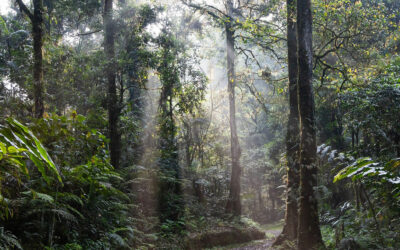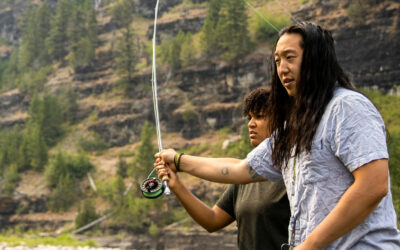Women camp near a glacier in Wrangell-St. Elias National Park and Preserve, an area which contains nearly ten million acres of designated wilderness, and has a array of connections to, and differing meanings for, many groups of people. Photo credit: National Park Service
The Future of Wilderness Research
A 10-Year Wilderness Science Strategic Plan for the Aldo Leopold Wilderness Research Institute
by JASON J. TAYLOR, TERESA N. HOLLINGSWORTH, CHRISTOPHER A. ARMATAS, KELLIE J. CARIM, KIRA L. HEFTY, OLGA HELMY, LISA M. HOLSINGER, DANETTE PAIGE, SEAN A. PARKS, LAUREN E. REDMORE, JACLYN F. RUSHING, ERANA J. TAYLOR, and KATHERINE A. ZELLER
Aldo Leopold Wilderness Research Institute, USDA Forest Service, Rocky Mountain Research Station, Missoula, MT USA

Aldo Leopold Wilderness Research Institute staff
Science + Research
June 2023 | Volume 29, Number 1
The Earth is changing faster than at any time in recorded history. Globally, we are facing large- scale losses in biodiversity and associated ecosystem function, changes in disturbance regimes, and widespread human migration and cultural loss (e.g., IPCC 2021). In the United States, we face many related challenges, including intensifying wildfire and climatic events, species and habitat loss, increasing demand for environmental and social justice, and rapid social change such as urbanization.
In 1964, the Wilderness Act codified formal protections for lands we know today as designated wilderness collectively, the National Wilderness Preservation System (NWPS), the most environmentally protected public lands in the United States. Wilderness is not only part of our national story. It also provides myriad benefits: from spiritual renewal and recreation opportunities to clean air and water, habitat for plants and wildlife, food and economic security, and opportunities to conduct scientific studies. Consequently, wilderness is important to many people as part of our collective past, present, and future. Wilderness can mean many different things to different people and expectations for uses, such as recreation and subsistence activities, vary depending on differences in cultural background, belief systems, and education, to name a few. Long-term protection required by law, combined with an increasing rate of climate change and a growing understanding of how Indigenous peoples cared for the lands now designated as wilderness, results in a complex wilderness stewardship landscape. Addressing this complexity would benefit from need-driven, collaborative, and inclusive science.
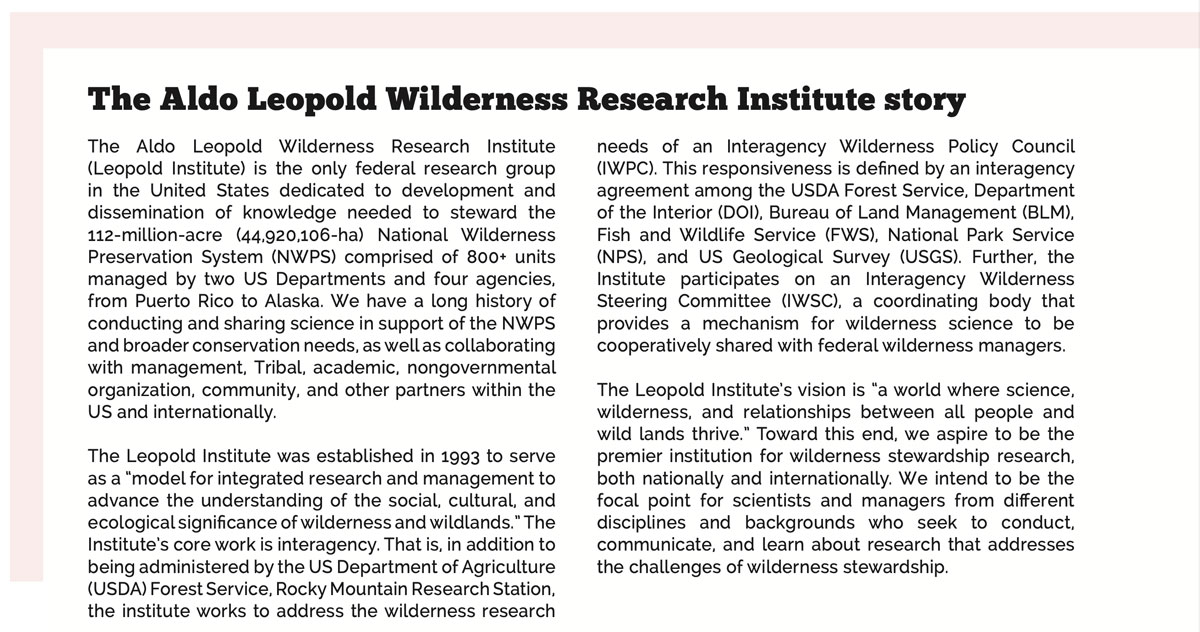
The Aldo Leopold Wilderness Research Institute (hereafter, Leopold Institute) is housed within the USDA Forest Service Rocky Mountain Research Station; however, it is an interagency institute that supports stewardship of the NWPS and broader conservation needs. Its mission is “Advancing wilderness stewardship through transformational science.” Within the USDA Forest Service, Research and Development Deputy Area, mission-driven programs are formalized in a Research Work Unit Description (i.e., a strategic plan or “science charter”) that is renewed on roughly 10-year cycles. In 2021, we developed a new strategic plan and science charter (hereafter, strategic plan) for the Leopold Institute to address key partner-identified wilderness research needs.
Developing a strategic plan for the Leopold Institute was a complex task, because: (1) science needs that are relevant to effective stewardship of the NWPS are diverse and expansive; (2) identifying our priority science needs required operating within the guiding policy for Leopold Institute scientists (e.g., the OPM Research-Grade Evaluation Guide), while taking into consideration the needs of management agencies and partners, as well as knowledge and opinions of a diverse range of wilderness stewards and interested parties; and (3) our capacity to conduct science is finite, shaped by the expertise and number of current Leopold Institute staff. In this article, we first describe our multipartner process for engaging a broad wilderness community that included all wilderness management agencies in the United States. (USDA-FS and US-DOI, BLM, FWS, and NPS) and other national and international partners, and then we introduce the strategic plan and Research Priority Areas that will guide the Leopold Institute’s science agenda for the next decade.
Multipartner Process
Our deliberate partner engagement process relied on Q-methodology (Stephenson 1954), a structured and statistically rigorous approach, to understand perspectives on the wilderness research priorities as identified by those who participated in the process. Q-methodology (Brown 1980; Watts and Stenner 2012; Armatas et al. 2018) involves a rank-ordering exercise, known as the Q-sort, which provides insight into the values and preferences held by participants about a topic of interest (Steelman and Maguire 1999). Specifically, it required partners to rank research priorities based on their professional and personal experiences. Because Q-methodology requires participants to evaluate trade-offs (i.e., research topics are prioritized relative to one another), it was particularly useful to planning since the Leopold Institute has finite resources, and therefore cannot address all the research topics that may be important or of interest to our many partners.
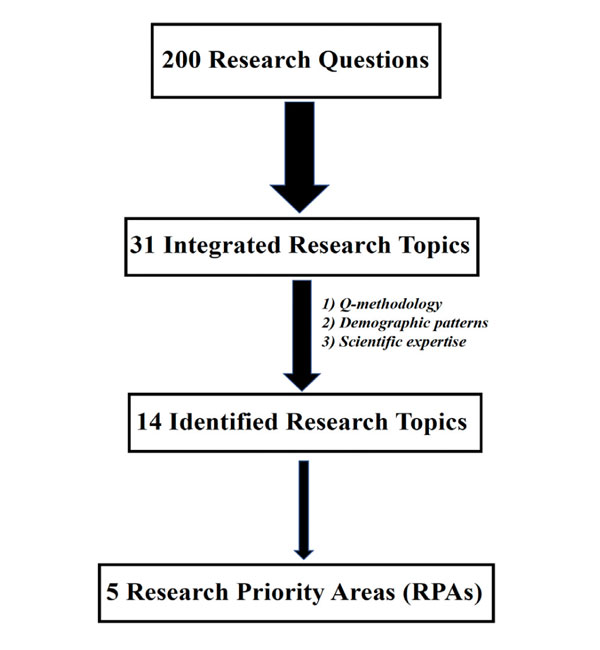
Figure 1 – Conceptual framework depicting our method for condensing and integrating more than 200 potential research questions into five Research Priority Areas that form the basis for the Leopold Institute 10-year strategic plan.
Q-methodology does not aim to measure the prevalence of any viewpoint (although this can be determined from partner input), but instead aims to explore and identify differing perspectives that can be thought of as lines of discourse in a conversation. It uses purposeful sampling to identify a group of participants who are likely to capture the diverse range of opinions around a topic. Participant perspectives are expressed primarily through the Q-sorting exercise, whereby 25–50 statements are arranged along a quasi-normal distribution from highest to lowest priority. Then, resisting a central tendency of opinion, statistical analysis of participant Q-sorts yields a limited number (often 3–5) of shared viewpoints.
We developed Research Priority Areas through the following seven, chronologically ordered, steps (Figure 1):
1. Develop of an initial potential set of Research Questions. Called the concourse in Q-methodology, concourse development served as an initial exploration of the innumerable statements around the topic of interest (i.e., research questions in our case). Leopold Institute scientists developed an initial concourse of 178 potential Research Questions, which was derived from the research needs outlined in previous science planning efforts (previous charters can be downloaded at https://leopold.wilderness.net/), literature focused on proposed wilderness and conservation science directions (Sutherland et al. 2009; Watson and Armatas 2018), and knowledge of Leopold Institute scientists and staff.
2. Expand the list of potential Research Questions through national and international partner engagement. The shared draft list was intended to represent the needs of a group of people who hold a diverse range of perspectives around the topic of interest; therefore, it was developed through strategic or purposeful (not random) sampling. The initial concourse was shared with a list of partners to elicit feedback, with the specific request to add other important research questions that may be missing. We sent this opportunity for engagement (via web application) to 160 people, mailing lists, organizations that represented agencies, tribes, NGOs, universities, interested public, special interest groups, and others in the US and globally. In turn, many of these people forwarded the opportunity for input to their networks and organizations. Additionally, the opportunity for engagement was posted on the Leopold Institute interagency website, available for anyone to participate. In total, the response rate included 232 unique visits to the web application and 117 total comments on our draft concourse. Regionally, we had responses from 31 states and Washington, D.C., in the United States and 24 international visits to the application with eight commenters. This partner engagement was made available from March 30–April 19, 2021, and resulted in an expansion of the concourse to more than 200 Research Questions.
3. Distill the concourse. We filtered the 200+ Research Questions into a “Q-set,” which is a tractable set of statements that broadly represent the ideas in the concourse and are sorted by participants (Watts and Stenner 2012). This effort generated 31 hierarchically integrated Research Topics for prioritization. These integrated Research Topics were intended to span broad social- ecological issues that incorporated research questions in a way that could be ranked by partners.
4. Prioritize Research Topics. Returning to the partner list and interagency website, we invited open participation to prioritize the 31 integrated Research Topics, based on individual views/opinions, using Q-methodology implemented through a web application. The resulting prioritized needs were known as the “Q-sort” and the respondents were known as the “P-set.” To conceptualize a “diverse” range of perspectives, we employed dimensional sampling (Arnold 1970). Partners provided information about demographics, including affiliation (USDA Forest Service, BLM, FWS, NPS, USGS, Tribal, university, state agency, NGO, and other); location (International, Eastern US –defined as any state east of the Rocky Mountains – Western US, and Alaska); and self-identified role (manager, policy maker, scientist/researcher, federal/ Tribal/state/NGO, wilderness stewards, interested public), which provided our dimensional sampling framework. In total, we had 175 complete responses (the P-set), which included 35 NPS, 35 university, 33 BLM, 29 Forest Service, 17 Tribal, 15 FWS, and 11 other respondents. This second phase of partner engagement took place between June 1–July 14, 2021.
5. Analyze input on research priorities and perspectives. Data analysis was both quantitative (summarizing response variation and means across the whole sample, identifying different perspectives with factor analysis, and examining patterns across and within various demographic groupings) and qualitative (conveying meaning to each factor array with the aid of information gathered during partner workshops). Analysis also identified where there was consensus, contention, and ambivalence among the research needs and perspectives (Armatas et al. 2014).
Patterns across and within demographic groups: The Q-sorting demographic data allowed us to use descriptive statistics to assess patterns in rankings across and among groups in an aggregate analysis. We assessed means, medians, high and low rankings across all participants, as well as within affiliation, location, and self- identified role. This analysis is limited in that our sample was nonrandom, and thus interpretation of our patterns cannot be used to assume broader patterns among agencies and other groups.
Evaluation of partner perspectives: We used factor analysis (PCA) in PQMethod (Schmolck 2014), a freely available software for analyzing Q-methodology data. Specifically, we used varimax rotation and refined with manual flagging at 0.05. Factor analysis allows for many unique partner perspectives to be combined or pared down to a limited number of typified viewpoints or “archetypes” expressed as a factor array, which is a Q-sort defined by all those participants that significantly load onto a particular factor or perspective. Each archetype is defined by participants that share a similar viewpoint or perspective.
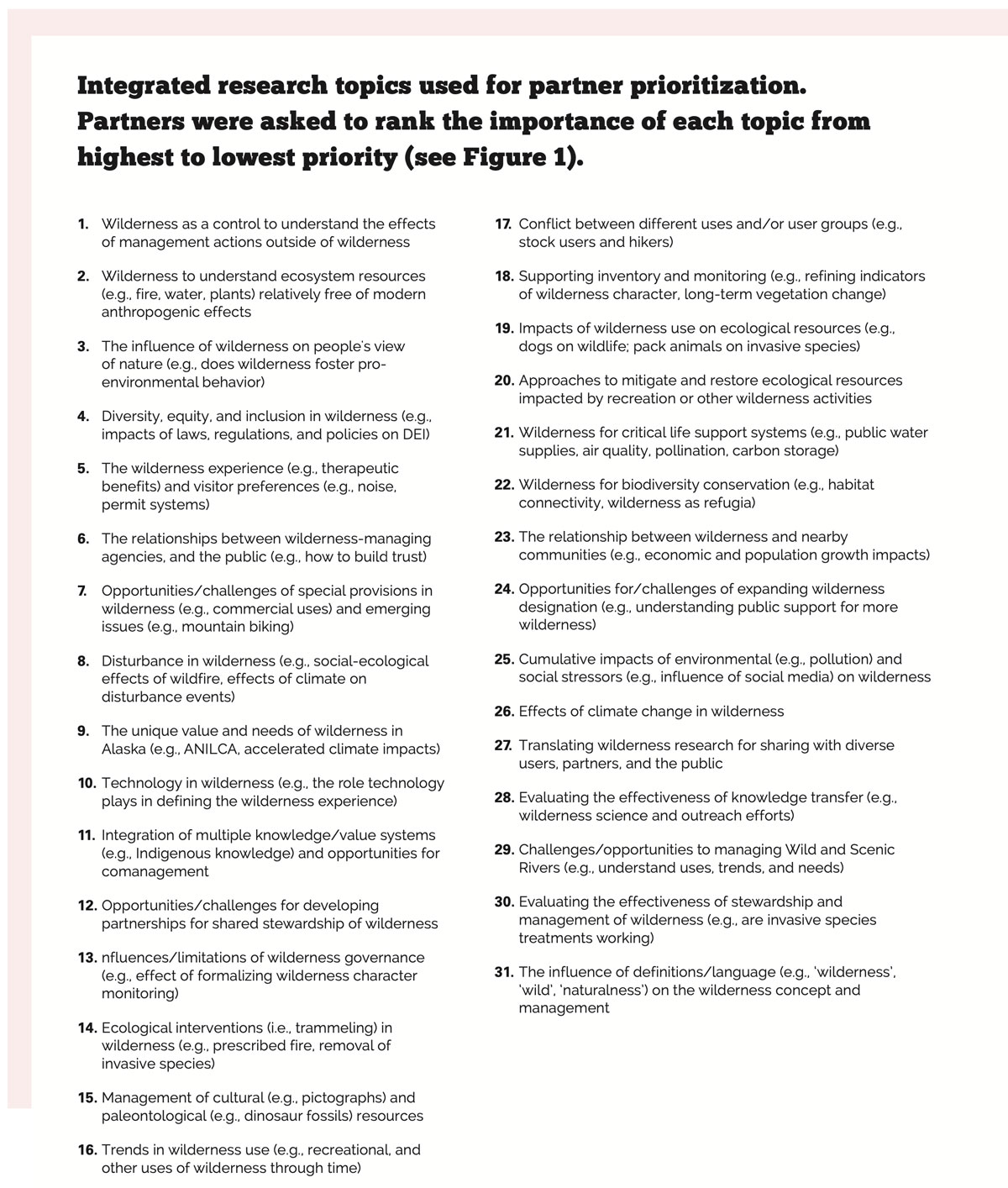
6. Conduct public workshops to clarify input. We conducted five public workshops with partners to share results to date and to understand the nuances and context within the typified perspectives. During the workshops, we presented the final factor solution and asked partners: (1) do any of the perspectives resonate with you, and if so, which one(s); (2) why do the perspectives resonate with you, and/or what is your reasoning for prioritizing the research topics as you did; and (3) what might you name the perspectives? In total, 33 people from the BLM, EPA, Forest Service, NPS, Arthur Carhart National Wilderness Training Center, state governments, universities, and nongovernmental organizations attended the workshops. Attendees spanned a variety of roles, including science leadership, communications and outreach, wilderness program management, and unit-level oversight (e.g., superintendents).
7. Translate research needs into a strategic plan. The partner engagement and analytical steps shared above developed a robust, albeit targeted, multi-angle understanding of wilderness research needs. These research needs were narrowed to a tractable, strategic list through several deliberate steps. We identified the highest- priority Research Topics by leveraging the five highest-ranking Research Topics from each perspective identified through the factor analysis, along with the five highest-ranking Research Topics from our demographic descriptive analysis from each of the NWPS management agencies and Tribal respondents. Then, Leopold Institute scientists identified which of these Research Topics they could address based on expertise and opportunity, and determined if other topics, based on expertise and current research, should be considered in the new strategic plan. Research Topics were then grouped into themed bins that ultimately became Research Priority Areas (RPAs), the focus of the new strategic plan. Leopold Institute leadership and scientists then generated overarching research questions that would develop core knowledge needed to meet the intent of each of the RPAs. We derived these overarching questions from a combination of detailed research needs identified earlier in the partner engagement process and expert opinion, including intimate awareness of outstanding needs within disciplinary fields among the scientists. Finally, scientists were asked to identify if, and how, overarching questions might be interrelated, acknowledging that addressing questions in one RPA might support other questions in other RPAs. In short, the new RPAs and accompanying strategic plan for the Leopold Institute emerged from intersecting partner perspective priorities, demographic patterns, and scientific expertise.
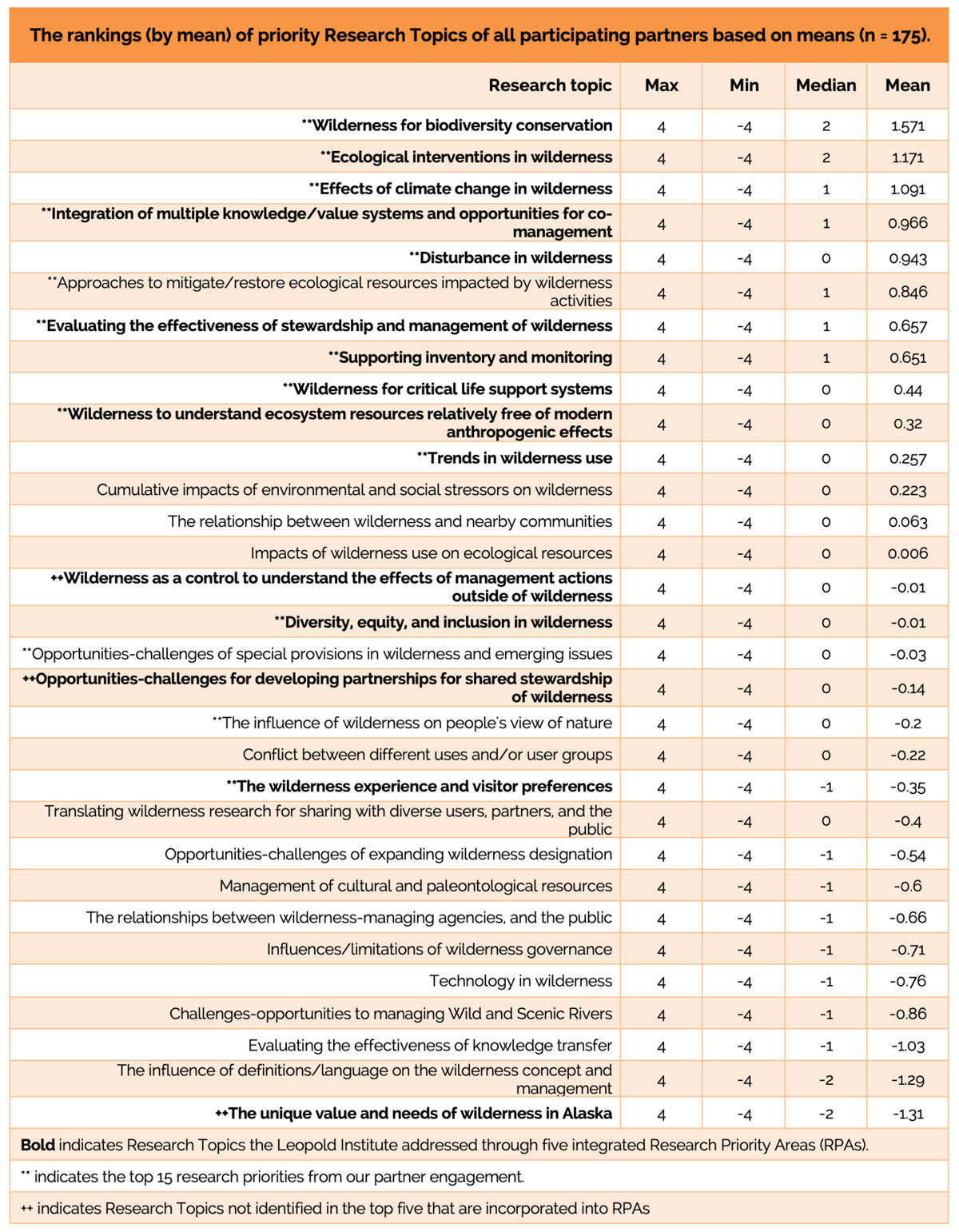
Table 1 – The rankings (by mean) of priority Research Topics of all participating partners based on means (n = 175). highest.
Results
Patterns across and within Demographic Groups
In reviewing Research Topic rankings, we observed patterns across all participants that were influenced by affiliation, region, and identified role. The participants were selected using a purposeful (not random) approach. Therefore, trends and priorities of the full sample should be interpreted within the context of the sample only and not the general population. Across all participants, the Research Topic with the highest priority on average was “Wilderness for biodiversity conservation” (mean = 1.571), and the Research Topic with the lowest priority was “The unique value and needs of wilderness in Alaska” (mean = -1.314) (Table 1). The possible range of scores for a Research Topic was -4 to +4, and surprisingly, every Research Topic had a maximum value of 4 and a minimum value of -4, which indicates that every Research Topic was ranked the highest at least once by a respondent, as well as ranked the lowest at least once by another respondent (Table 1). We also observed geographic patterns, such as Alaskan respondents rank- ing “The unique value and needs of wilderness in Alaska” higher in importance than average (third highest in Alaska vs. lowest priority overall).
Evaluation of Partner Perspectives
Analyzing partner input, we identified that Research Topic rankings generally organized into three groups, with little overlap between the groups. There were three primary perspectives (called “typified responses”) that emerged from the input, where rankings for all participants within a given, typified response were similar (with some variation) to one another. The three perspectives were ultimately labeled: Perspective 1 – Societal, Perspective 2 – Ecological, and Perspective 3 – Managerial, since the types of questions that had the highest priority in each group were largely societal, ecological, or managerial, respectively (Figures 2a, 2b, 2c). These results are consistent with overall patterns across demographic groups (comparing Figure 2 to Table 1).

Figure 2 a-c – Research Topics “perspectives” as defined by factor analysis, i.e., typified partner responses, (a) Perspective 1 has societal topics ranked highest, (b) Perspective 2 has ecological topics ranked highest, and (c) Perspective 3 has managerial topics ranked highest.
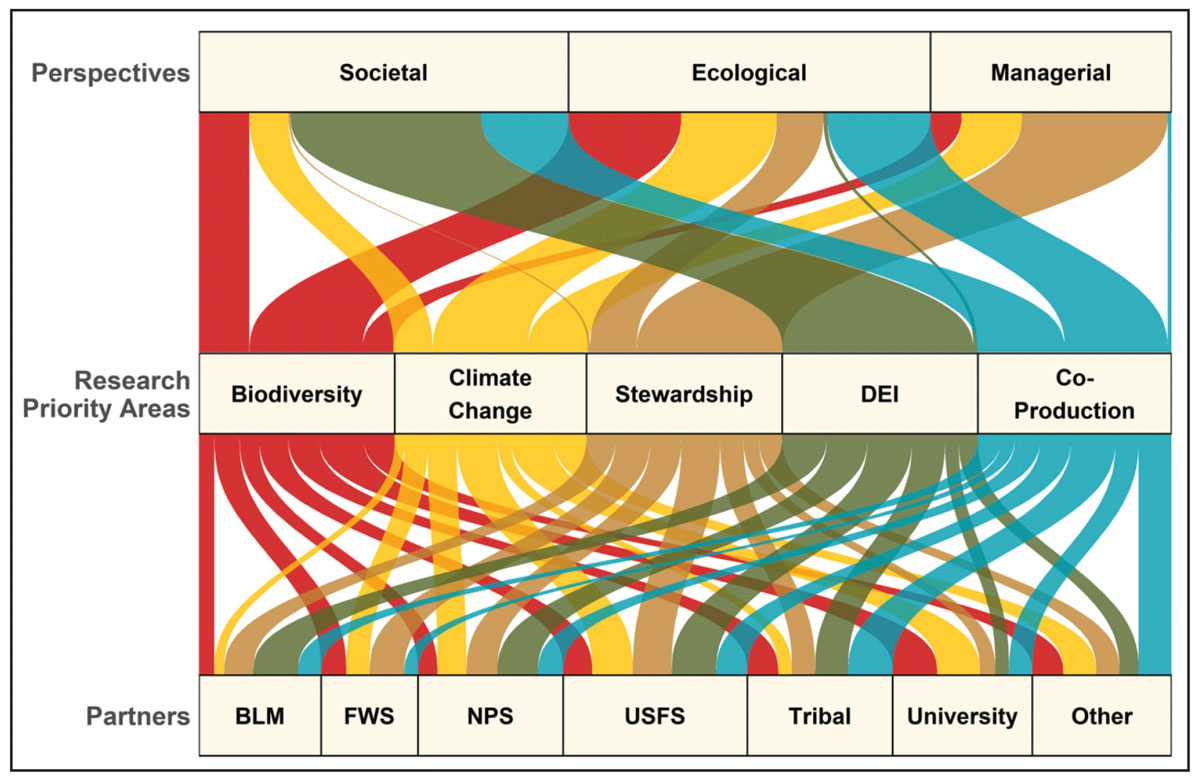
Figure 3 – The Leopold Institute Research Priority Areas, as identified through the partner engagement process and the influence of partner priorities and perspectives on those RPAs. The width of the lines indicates the influence of each perspective (based on additive z-scores, from the Factor Analysis) and partner priority (based on mean ranking) to each RPA.partners based on means (n = 175). highest.
Translating Research Needs into a Strategic Plan and Science Charter
Intersecting the five highest Research Topics from each perspective (social, ecological, and managerial) (Figure 2), along with the five highest-ranked Research Topics from our descriptive analysis from each of the NWPS management agencies and Tribal respondents resulted in an initial selection of 15 priority Research Topics (out of 31 possible) for further consideration (Table 1). Of those 15 Research Topics, Leopold Institute scientists identified 11 they could address based on expertise and opportunity.
Three additional Research Topics (“Wilderness as a control to understand the effects of management actions outside of wilderness,” “Opportunities/Challenges for developing partnerships for shared stewardship of wilderness,” and “The unique value and needs of wilderness in Alaska”), while not identified in the top five Research Topics from each perspective or agency and Tribal responses, were identified by Leopold Institute scientists or leadership as important to include in our strategic plan. Each of these added topics was on the higher side of importance for at least one perspective, and additionally, each directly aligned with needs identified by managerial or research partners through informal dialogue. A total of 14 identified Research Topics (out of 31 considered and ranked) were ultimately carried forward (Table 1) as part of our strategic plan. Toward creating a more tractable and manageable number of programmatic priorities, the 14 identified Research Topics were thematically integrated to create five RPAs. Collectively the RPAs capture both perspective (typified response from our Q-methodology factor analysis) and raw (based on source data mean rankings) research needs and provided the foundation upon which the Leopold Institute strategic plan was developed (Figure 3).
Research Priority Areas
RPA1. Biodiversity Conservation (labeled as “Biodiversity” in figures): Develop an understanding of the values, opportunities, and challenges for wilderness to support biodiversity conservation in an era of unprecedented change. This RPA includes research topics: “Wilderness for biodiversity conservation,” “Wilderness to understand ecosystem resources relatively free of modern anthropogenic effects,” and “Wilderness for critical life support systems.” To address RPA1, the Leopold Institute will advance wilderness-relevant biodiversity conservation knowledge across multiple temporal and spatial scales by addressing the following, overarching research questions (Figure 4):
h. How well does the NWPS cover the diversity of ecoregions and ecosystems within the US, and where are key areas of ecological importance that remain unprotected?
i. Are wilderness and protected areas sufficiently large, distributed, and connected to support long-term viability of biodiversity and critical (human) life support systems?
j. What are the benefits and limitations of wilderness for supporting fish and wildlife biodiversity and related human uses (e.g., subsistence)? (Link to RPA4)
RPA2. Climate Change and Disturbance (labeled as “Climate change”): Improve knowledge about the impacts and consequences of climate change and climate-disturbance interactions, including wildland fire, relevant to wilderness stewardship. This RPA includes research topics: “Effects of climate change in wilderness,” “Disturbance in wilderness,” and “Wilderness as a control to understand the effects of management actions outside of wilderness.” To address RPA2, the Leopold Institute will advance knowledge related to climate change, disturbance, and wilderness by addressing the following, overarching research questions (Figure 4):
a. How do climate change and climate-mediated disturbances, such as fire, affect biodiversity, ecosystem processes, and connectivity in wilderness? (Link to RPA1)
b. How does wilderness contribute to a broader understanding of the effects of climate change and climate-disturbance interactions on landscapes, ecosystems, and people?
c. Do wilderness areas serve as climate refugia and/or stepping stones for biodiversity at multiple scales, and if so, how? (Link to RPA1)
d. How will climate change affect human–nature relationships within the wilderness context? (Link to RPA4)
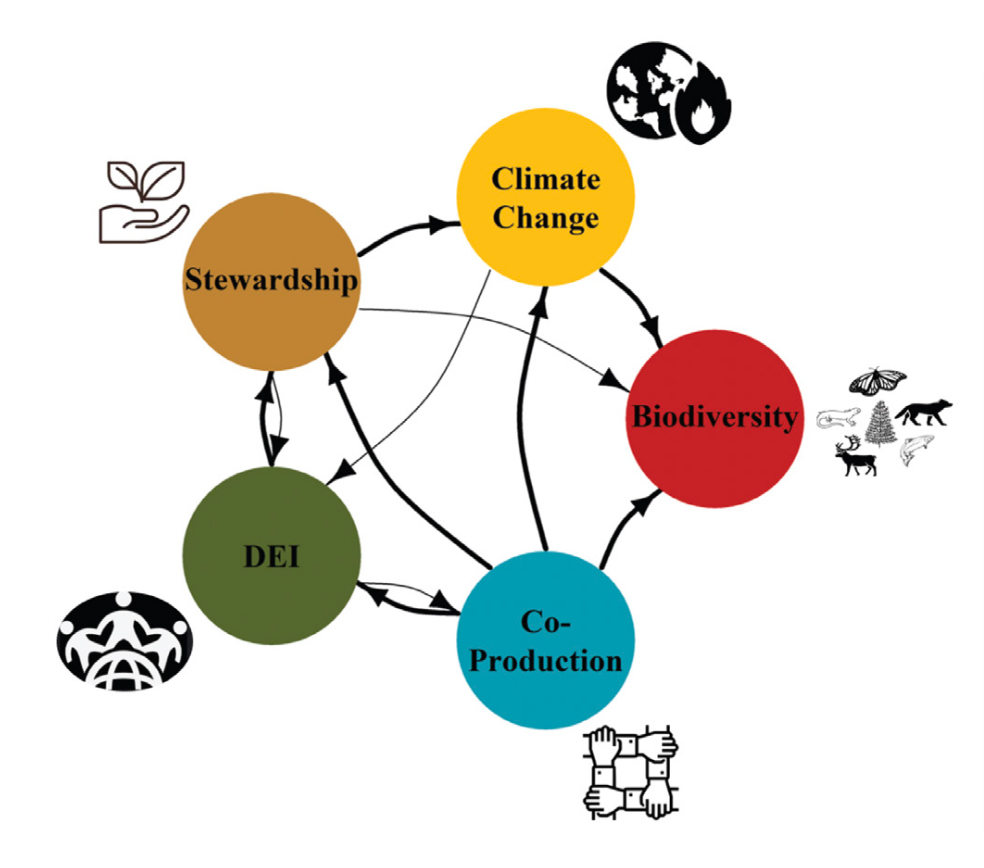
Figure 4 – Linkages (arrows) between research questions within the Leopold Institute Research Priority Areas (see Figure 3). RPAs with linkages have research questions that are intercon- nected. Thicker arrows represent multiple research questions within an RPA that connects with another RPA.
RPA3. Stewardship Effectiveness (labeled as “Stewardship”): Examine the effects and effective- ness of wilderness stewardship decisions, including the potential for and effects of management interventions. This RPA includes research topics: “Evaluating the effectiveness of stewardship and management of wilderness” and “Ecological interventions in wilderness.” To address RPA3, the Leopold Institute will develop an understanding about the effectiveness of and opportunities for wilderness management interventions and other decisions, in the context of climate change and other drivers, by addressing the following, overarching questions (Figure 4):
a. What is the spatial and temporal variation in management objectives and interventions across the NWPS?
b. How do wilderness stewardship decisions and practices affect wilderness character, visitor preference, biodiversity, and ecosystem function? (Link to RPA1, RPA4, and RPA 5)
c. What are the short- and long-term social-ecological trade-offs (benefits and costs) of resisting, accepting, or directing wilderness ecosystems in the context of climate change? (Link to RPA2)
RPA4. Relevance and Inclusivity (labeled as “DEI”): Expand our understanding of wilderness relevance, experiences, inclusivity, and use amid social-ecological change. This RPA includes research topics: “Trends in wilderness use,” “The wilderness experience and visitor preferences,” “Diversity, equity, and inclusion in wilderness,” and “The unique value and needs of wilderness in Alaska.” To address RPA4, the Leopold Institute will advance knowledge around wilderness use, experience, and relevance relative to a changing society by addressing the following, overarching research questions (Figure 4):
a. What is the relevancy of wilderness to a diverse America, and how has that changed over time?
b. How do underrepresented and underserved communities define and engage with wilderness and what social-ecological factors affect their relationships with wilderness?
c. What is the impact of DEI wilderness programming, and how can wilderness managers increase inclusive use of, and experience in, wilderness for historically excluded groups? (Link to RPA3)
d. How does the Alaska National Interest Lands Conservation Act interact with the Wilderness Act and affect the wilderness use opportunity? (Link to RPA3 and RPA5).
RPA5. Shared Stewardship (labeled as “Co-production”): Improve our understanding of co-production approaches and abilities to harmonize multiple knowledge systems toward more inclusive wilderness stewardship. This RPA includes research topics: “Integration of multiple knowledge/ value systems” and “Opportunities/Challenges for developing partnerships for shared stewardship of wilderness.” To address RPA5, the Leopold Institute will advance knowledge around harmonizing multiple ways of knowing to support co-producing wilderness stewardship by addressing the fol- lowing, overarching research questions (Figure 4):
a. How can Western and Indigenous knowledge systems be harmonized to create a more inclusive and richer understanding of wilderness character and improve best practices for wilderness research, stewardship, and management interventions? (Link to RPA1, RPA2, RPA3, and RPA4)
b. How/what does co-produced stewardship look like in practice? And how can we leverage this understanding to improve wilderness research, stewardship, and planning efforts? (Link to RPA1, RPA2, RPA3, RPA4)
“…we recognized that wilderness stewardship is complex; wilderness areas are part of the larger social, cultural, political, and ecological landscapes in which they exist. In addition, the benefits, values, threats to, and stewardship of wilderness commonly have social and ecological opportunities and consequences both within and outside of wilderness.”
Discussion
In developing our strategic plan, we recognized that wilderness stewardship is complex; wilderness areas are part of the larger social, cultural, political, and ecological landscapes in which they exist. In addition, the benefits, values, threats to, and stewardship of wilder- ness commonly have social and ecological opportunities and consequences both within and outside of wilderness. Further, while there is obvious benefit in both basic and applied science, the Leopold Institute leans toward applied research that supports stewardship of the NWPS. Therefore, we strived to develop broad RPAs that have an interdisciplinary focus, and that are inclusive of managerial, ecological, and social perspectives. Here, we discuss the relevance of our chosen RPAs in the context of wilderness science and regional, national, and international priorities.
RPA1: Biodiversity Conservation
Biodiversity is essential for the functioning of ecosystems and human well-being. The Millennium Ecosystem Assessment (2005) highlighted the consequences of biodiversity loss as well as the degradation of ecosystem functionality. Therefore, the conservation of biological diversity (including genetic, spe- cies, biological communities, ecosystems, processes, and landscapes) has become an increasingly important goal globally, and specifically for many protected areas, including wilderness (Mittermeier et al. 2003). Effective stewardship of biodiversity requires understanding the patterns of biodiversity across and among wilderness and similarly protected areas, the mechanisms underlying the persistence of biodiversity in a wilderness setting, the effects of wilderness management on biodiversity and natural-resource-dependent people, the role of wilderness areas as potential hubs of biodiversity in a diverse matrix of land ownership and management, and conversely, the limitations of wilderness designations to protect biodiversity.
Areas designated as wilderness (the NWPS within the US, and IUCN Category Ib, inter- nationally) receive a strict form of protection. This level of protection may promote and protect biodiversity by providing safe havens, or refugia, for animals and plants and be particularly important for species of conservation concern under increasing environmental stress (Watson et al. 2014; Pacifici et al. 2020). If protected and connected by corridors, wilderness may help mediate the effects of fragmentation and climate change, allow for the natural flow of ecological processes, and maintain gene flow and species viability (Belote et al. 2016). Wilderness areas provide an opportunity to investigate what may be one of the best-case scenarios for species persistence, maintenance of biodiversity, and ecosystem function in an era of unprecedented change.
RPA2: Climate Change and Disturbance
Earth’s average surface temperature has risen about one degree Celsius since the late 19th century, driven largely by increased carbon dioxide emission and other human activities (Marcott et al. 2013). Human influence has warmed the climate at a rate that is unprecedented in at least the last 2000 years, with most of the warming occurring in the past 40 years (IPCC 2021). Climate change affects ecological systems via direct impacts such as drought and glacial melt, as well as indirectly through changes in disturbance regimes. The protection of landscapes relatively free from direct alteration by modern development, such as wilderness, may buffer impacts of climate change. This buffering capacity could be localized, whereas wilderness provides refuge for climate-sensitive species. It may also be broad scale with benefits to society outside wilderness boundaries, such as water retention that buffers floods and drought and carbon storage. In addition, wilderness has the potential to provide a reference point, or research control, for understanding how changes in broad-scale drivers affect land- scapes that are both less and more impacted by modern development.
Climate change is resulting in increases in area burned by wildland fire in the western United States and North American boreal forests including Alaska (Kasischke and Turetsky 2006; Abatzoglou and Williams 2016; Parks and Abatzoglou 2020), which is arguably one of the most pervasive and prevalent disturbance agents affecting both wilderness and nonwilderness globally (Bowman et al. 2009). Recent wildfires in the western United States and Alaska are thought to have burned in a manner that is considered “uncharacteristically severe” compared to fires that burned in past centuries (Duffy et al. 2005; Mallek et al. 2013; Haugo et al. 2019). As wildfire increasingly threatens ecosystem sustainability and communities broadly, lessons learned from fire in wilderness may help more effectively under- stand and manage fires outside of wilderness.
The impacts of a changing climate on how people interact with, and experience, wilderness resources are likely to be significant. Social impacts of climate change on wilderness spans a diversity of people, economies, and values. For example, peak season and travel patterns could be affected, as well as recreation opportunities, cultural resources, and distribution of fish and game species. Furthermore, it is unclear how climate change will impact different groups of people disproportionately when wilderness is, for instance, traditional homelands of Indigenous Americans, a place to connect to the natural world for urban Americans, and a hazard to forest-proximate residents concerned about wildfire. Understanding how climate change will impact wilderness ecosystems, as well as people’s relationships with wilderness, can provide stewards with the knowledge and feasibility of potential adaptation approaches. Increasing wilderness-relevant climate change knowledge can inform best practices for stewardship of wilderness recreation, help us understand the relevance of wilderness for broader society, and ultimately may promote the preservation of wilderness areas in general.
RPA3: Stewardship Effectiveness
The 1964 Wilderness Act and subsequent wilderness legislation identify wilderness as “an area where the earth and its community of life are untrammeled by man” and “retaining its primeval character and influence.” The Wilderness Act further directs that wilderness be “protected and managed so as to preserve its natural conditions and which (1) generally appears to have been affected primarily by the forces of nature, with the imprint of man’s work substantially unnoticeable; and (2) has outstanding opportunities for solitude or a primitive and unconfined type of recreation.”
Values related to both naturalness and wildness are central to the wilderness concept (Cole and Yung 2012). However, managers and scientists have increasingly questioned the feasibility and meaning of maintaining naturalness, as historically defined, in wilder- ness (Landres et al. 2000). There is a growing awareness that (1) past Indigenous land management practices often produced the landscapes identified today as “wilderness,” and (2) Indigenous Knowledge can broaden understanding of natural ecosystems (Fletcher et al. 2021). Contrary to earlier assumptions that natural ecosystems are stable and self- regulating, scientists now know that natural ecosystems are highly dynamic. Scientists also now know most of the world’s ecosystems, including the most remote wilderness areas, have been modified to some extent by human activity. Considering increased knowledge about historical and current human influence on wilderness areas, “naturalness” may no longer fully capture the evolving and expanding perspectives on wilderness values. Human activities, including climate change, are altering wilderness ecosystems, and therefore managers must decide if intervention(s) may be appropriate (Hobbs et al. 2010).
Management decisions, both inside and outside wilderness areas can affect the structure and functioning of wilderness ecosystems. Understanding the cascading effects of these decisions across spatial and temporal scales can inform how management actions are influencing wilderness character and help target passive management activities that promote biodiversity conservation and ecosystem function across wilderness boundaries. Restoring and/or maintaining the natural function of ecosystems, particularly in the face of climate change, may involve management interventions that create trade-offs in wilderness qualities on different time scales. Understanding trade-offs between the costs and benefits of implementing management interventions, as well as the temporal scale of impacts to wilderness character associated with management inside of wilderness, may help prioritize whether, and if so, which, management interventions are necessary to preserve wilderness character for future generations.
RPA4: Relevance and Inclusivity
The opening lines of the Wilderness Act state: “An Act to establish a National Wilder- ness Preservation System for the permanent good of the whole people.” Today, we have yet to meet that ideal. There remain varying opportunities, or lack thereof, to access wilderness for people who were historically excluded from wilderness; for example, Indigenous Americans, people of color, immigrants and new Americans, people with disabilities, and people who identify as LGBTQIA+. The study of diversity, equity, and inclusion in wilderness is especially important when you consider the origins of wilderness in contrast to our increasingly diverse society.
There is a long history of forced removal of Indigenous Americans and other people of color from lands that became wilderness. Early romantic ideals of wilderness conceptualized a place devoid of humans, mostly in the western United States, that is often inaccessible to all except the “rugged” individual – for most of recent history, white, upper-class men (e.g., Stankey 1989; Deluca and Demo 2001; Johnson et al. 2004; Corliss 2019; Davis 2019). This, in part, is an artifact of who had political power, and who counted or could vote at the time wilderness designations were made. Further, shifts in demography, changes in technology, environmental changes, variation in uses, and an emerging understanding of the traditional knowledge that shaped the environment settled by Europeans all bring opportunity and complexity to wilderness stewardship. Adding to the complexity and opportunity, wilderness areas in Alaska, total- ing more than 57 million acres (23,067,081 ha) or just over half of the NWPS, are legislatively mandated through the 1980 Alaska National Interest Lands Conservation Act as “inhabited wilderness,” particularly as it relates to subsistence use by rural residents (Starkey 2016).
A better understanding of the evolution of wilderness values, uses, and experiences as well as improved delivery of wilderness bene- fits is needed to foster wilderness stewardship that protects opportunities for all Americans. This includes evaluating temporal and spatial trends in use, how experiences and trends vary based on social-ecological factors, and the preferences, barriers, and incentives to wilderness access for communities that have been historically excluded from and/or under- served with respect to federally designated wilderness. Improved information on how societal demographics are changing and how those changes impact the way people value and use wilderness has important implications for successful wilderness stewardship and improving the relevancy of wilderness.
RPA5: Shared Stewardship
Co-production brings together people with different knowledge, expertise, and experiences to determine specific problems and to cooperatively define the scope and context of those problems (e.g., Campbell et al. 2016). The co-production process includes identify- ing potential research questions and research methods, and make scientific inferences and develop strategies to address those problems. Co-production acknowledges the interdependence between fact and values, with an overarching goal to build investment in both knowledge and outcomes and requires that all partners are willing to engage with humility and are open to ideas different from their own. Wilderness research and stewardship may benefit from participation of multiple partners who are invested in problem development and improved outcomes; however, such co-produced work is often challenging to put into practice given that partners have different life experiences, values systems, worldviews, and areas of expertise.
Research and management decisions are often made without directly incorporating multiple worldviews. Biocultural approaches to wilderness stewardship aim to consider the diversity of life in all its manifestations, thereby acknowledging a plurality of worldviews and human–nature interactions (Gavin et al. 2015). Such approaches are particularly inclusive of different ways of knowing, including local ecological knowledge, cultural values, traditional practices, and natural scientific knowledge. Harmonization of multiple ways of knowing through a biocultural lens would increase our understanding of wilderness use, experience, importance, and the very meaning of wilderness. The Leopold Institute is committed to using, and advancing through research, a biocultural lens to co-produce wilderness stewardship with a diversity of partners, including managers of wilderness, Indigenous tribes and community members, scientists, policy makers, NGOs, interested publics, and others.
Translating Research Needs into a Strategic Plan and Science Charter
Firsthand experience of several coauthors has shown us that strategic planning efforts often successfully identify an extensive “library” of needs and equally often fall short of the hard decision-making needed to move from that extensive list to strategic, priority-based, capacity- relevant, program direction. The Leopold Institute, consisting of five research-grade scientists and several supporting scientists and staff, is charged with development and dissemination of knowledge needed to steward the 112-million-acre (44,920,106-ha) NWPS, all 800+ units man- aged by two US Departments and four agencies, from Puerto Rico to Alaska. The scope of this responsibility compared to the size of our team dictates that it is not possible for us to address all wilderness research needs. Therefore, establishing focal research themes that addressed the highest priority needs was essential to advancing a sustainable and relevant program of work.
Our intention in developing a new strategic plan for the Leopold Institute was to identify roughly five Research Priority Areas. Our process to get there was supported largely through the science and logistics around deploying Q-methodology, followed by deliberate program leadership decision-making. In this way the Leopold Institute engaged in a stepwise effort, which included almost 200 partners, to identify five Research Priority Areas from an initial list of more than 200 potential research questions. We acknowledge that our final Research Priority Areas will not align with all partners’ priority research needs. Five Research Priority Areas, with three to five overarching questions each, is well short of 200 potential questions, which in turn is likely well short of the actual need, both nationally and globally. In the end, we strived to develop broad RPAs that have an interdisciplinary focus; are inclusive of managerial, ecological, and social perspectives; and that could be addressed based on expertise and opportunity at the Leopold Institute. We are hopeful that our inclusive approach to developing a strategic plan and science charter at the Leopold Institute will help ensure that our research efforts address the most pressing questions and generate meaningful knowledge related to wilderness and wilder- ness stewardship over the next decade.
Acknowledgments
Much of the text herein was taken from the RMRS Aldo Leopold Wilderness Research Institute’s Research Work Unit Description (i.e., Science Charter), signed April 27, 2022, a formal, unpublished document developed by this manuscript’s coauthors. This document is available for download at https://leopold.wilderness.net/news/stories/new-strategic-plan-science-charter. php. Our web interface used to generate partner input was designed by Josh Gage. Our strategic planning process kicked-off via training conducted by Charles Besancon at Global Park Solutions. We gratefully acknowledge the input of the Interagency Wilderness Steering Committee throughout the strategic planning process and editorial comments on the manuscript by Robert Dvorak.
About the Authors
JASON J. TAYLOR is director of the Aldo Leopold Wilderness Research Institute (ALWRI) and a landscape ecologist with more than 20 years of federal and local government service.
TERESA N. HOLLINGSWORTH is deputy director of ALWRI and a plant ecologist with experience in disturbance-driven ecosystem ecology.
CHRISTOPHER A. ARMATAS is a research social scientist at ALWRI focused on wildlands stewardship through a social-ecological lens.
KELLIE J. CARIM is a research ecologist at ALWRI focused on population structure, and persistence of aquatic species.
KIRA L. HEFTY is a biological scientist at ALWRI with a background in wildlife distribution, biodiversity, and landscape connectivity modeling.
OLGA HELMY is a science delivery specialist at ALWRI with a background in graphic design, data visual- ization, and interpretive writing to communicate science to diverse audiences.
LISA M. HOLSINGER was an ecologist at ALWRI with more than 15 years’ experience conducting geospatial analyses of natural resources.
DANETTE PAIGE is a support services specialist at ALWRI and the initial contact for visitors to the institute.
SEAN A. PARKS is a research ecologist at ALWRI focused on changes in fire regimes within and outside wilderness.
LAUREN E. REDMORE is a research social scientist at ALWRI focused on the relationships between people and the environment with consideration for wider historical and political contexts.
JACLYN F. RUSHING is a social scientist at ALWRI with a background in recreation and protected areas management.
ERANA J. TAYLOR is a postdoctoral research ecologist at ALWRI focused on climate change adaptation in wilderness.
KATHERINE A. ZELLER is a research biologist at ALWRI focused on integration of spatial ecology, landscape ecology, wildlife biology, and biostatistics.
References
Abatzoglou, J. T, and A. P. Williams. 2016. Impact of anthropogenic climate change on wildfire across western US forests. Proceedings of the National Academy of Sciences 113(42): 11770–11775. https://doi.org/10.1073/ pnas.1607171113.
Armatas, C. A , R. M. Campbell, A. E .Watson, W. T. Borrie, and T. J. Venn. 2018. An integrated approach to valuation and tradeoff analysis of ecosystem services for national forest decision-making. Ecosystem Services 33: 1–18.
Armatas, C. A., T. J. Venn, and A. E. Watson. 2014. Applying Q-methodology to select and define attributes for non- market valuation: A case study from northwest Wyoming, United States. Ecological Economics 107: 447–456.
Arnold, D. O. 1970. Dimensional sampling: An approach for studying a small number of cases. American Sociologist 5(2):147–150.
Belote, R. T., M. S. Dietz, B. H. McRae, D. M. Theobald, M. L. McClure, G. H. Irwin, P. S. McKinley, J. A. Gage, and G. H. Aplet. 2016. Identifying corridors among large protected areas in the United States. PLoS One 11:e0154223.
Bowman, D. M., J. K. Balch, P. Artaxo, W. J. Bond, J. M. Carlson, M. A. Cochrane, C. M. D’Antonio, R. S. DeFries, J. C. Doyle, S. P. Harrison, F. H. Johnston, J. E. Keeley, M. A. Krawchuk, C. A. Kull, J. B. Marston, M. A. Moritz, I. C. Prentice, C. I. Roos, A. C. Scott, T. W. Swetnam, G. R. Van der Werf, and S. J. Pyne. 2009. Fire in the Earth system. Science 324: 481–484. https://doi.org/10.1126/science.1163886.
Brown, S. R. 1980. Political Subjectivity: Applications of Q Methodology in Political Science. New Haven, CT: Yale University Press.
Campbell, L. K., E. S. Svendsen, and L. A. Roman. 2016. Knowledge co-production at the research–practice interface: Embedded case studies from urban forestry. Environmental Management 57: 1262–1280.
Cole, D. N., and L. Yung. 2012. Beyond Naturalness: Rethinking Park and Wilderness Stewardship in an Era of Rapid Change. Washington, DC: Island Press.
Corliss, J. 2019. White wilderness: Race, capitalism, and alternative knowledges of natural space. Master’s thesis, DePaul University, Chicago, Illinois.
Davis, J. 2019. Black faces, black spaces: Rethinking African American underrepresentation in wildland spaces and outdoor recreation. Environment and Planning E: Nature and Space 2(1): 89–109.
DeLuca, K. M., and A. T. Demo. 2001. Imagining nature and erasing class and race: Carleton Watkins, John Muir, and the construction of wilderness. Environmental History 6: 541–560.
Duffy, P. A., J. E. Walsh, J. M. Graham, D. H. Mann, and T. S. Rupp. 2005. Impacts of large-scale atmospheric-ocean variability on Alaskan season severity. Ecological Applications 15: 1317–1330.
Fletcher, M-S, R. Hamilton, W. Dressler, and L. Palmer. 2021. Indigenous knowledge and the shackles of wilderness. Proceedings of the National Academy of Sciences 118:e2022218118.
Gavin, M. C., J. McCarter, A. Mead, F. Berkes, J. R. Stepp, D. Peterson, and R. Tang. 2015. Defining biocultural approaches to conservation. Trends in Ecology and Evolution 30(3):140–145. https://doi.org/10.1016/j. tree.2014.12.005.
Haugo, R. D., B. S. Kellogg, C. A. Cansler, C. A. Kolden, K. B. Kemp, J. C. Robertson, K. L. Metlen, N. M. Vaillant, and C. M. Restaino. 2019. The missing fire: Quantifying human exclusion of wildfire in Pacific Northwest forests, USA. Ecosphere 10(4): d02702 https://doi.org/10.1002/ecs2.2702.
Hobbs, R. J., D. N. Cole, L. Yung, E. S. Zavaleta, G. H. Aplet, F. S. Chapin III, P. B. Landres, D. J. Parsons, N. L. Stephen- son, and P. S. White. 2010. Guiding concepts for park and wilderness stewardship in an era of global environmental change. Frontiers in Ecology and the Environment 8: 483–490.
IPCC. 2021. Climate Change 2021: The Physical Science Basis. Contributions of Working Group 1 to the Sixth Assessment Report of the Intergovernmental Panel on Climate Change. Cambridge, UK: Cambridge University Press.
Johnson, C. Y., M. J. Bowker, J. C. Bergstrom, and H. K. Cordell. 2004. Wilderness values in America: Does immigrant status or ethnicity matter? Society and Natural Resources 17: 611–628.
Kasischke, E. S., and M. R. Turetsky. 2006. Recent changes in the fire regime across the North American boreal region – Spatial and temporal patterns of burning across Canada and Alaska. Geophysical Research Letters 33(9): https://doi.org/10.1029/2006GL025677.
70 International Journal of Wilderness | June 2023 | Volume 29, Number 1
Landres, P. B., M. W. Brunson, L. Merigliano, C. Sydoriak, and S. Morton. 2000. Naturalness and wildness: The di- lemma and irony of managing wilderness. In Wilderness Science in a Time of Change Conference. USDA Forest Service, Rocky Mountain Research Station, Missoula, Montana.
Mallek, C., H. Safford, J. Viers, and J. Miller. 2013. Modern departures in fire severity and area vary by forest type, Sierra Nevada and Southern Cascades, California, USA. Ecosphere 4(12): art153. https://doi.org/10.1890/ES13- 00217.1.
Marcott, S. A., J. D. Shakun, P. U. Clark, and A. C. Mix. 2013. A reconstruction of regional and global temperature for the past 11,300 years. Science 339: 1198–1201.
Millennium Ecosystem Assessment. 2005. Ecosystems and Human Well-Being: Synthesis. Washington, DC: Island Press.
Mittermeier, R. A., C. G. Mittermeier, T. M. Brooks, and C. Kormos. 2003. Wilderness and biodiversity conservation. Proceedings of the National Academy of Sciences 100: 10309–10313.
Pacifici, M., M. Di Marco, and J. E. M. Watson. 2020. Protected areas are now the last strongholds for many imperiled mammal species. Conservation Letters 13: e12748.
Parks, S. A., and J. T. Abatzoglou. 2020. Warmer and drier fire seasons contribute to increases in area burned at high severity in western US forests from 1985 to 2017. Geophysical Research Letters 47(22): e2020GL089858. https:// doi.org/10.1029/2020GL089858.
Schmolck, P. 2014. “PQMethod (version 2.35) available at URL: http://schmolck.org/qmethod/.
Stankey G. H. 1989. Beyond the campfire’s light: Historical roots of the wilderness. Journal of Natural Resources 29(1): 9–24.
Starkey, J. S. 2016. Protection of Alaska Native customary and traditional hunting and fishing rights through Title VIII of ANILCA. Alaska Law Review 33: 315.
Steelman, T. A., and L. A. Maguire. 1999. Understanding participant perspectives: Q-methodology in national forest management. Journal of Policy Analysis and Management 18(3): 361–388.
Stephenson, W. 1954. The Study of Behavior: Q-Technique and Its Methodology. Vol. 29. Chicago: The University of Chicago Press. https://doi.org/10.2307/2281274.
Sutherland, W. J, W. M. Adams, R. B. Aronson, R. Aveling, T. M. Blackburn, S. Broad, G. Ceballos, I. M. Cote, R. M. Cowl- ing, G. A. B. Da Fonseca, E. Dinerstein, P. J. Ferraro, E. Fleishman, C. Gascon, M. Hunter Jr., J. Hutton, P. Lareiva, A. Kuria, D. W. Macdonald, K. Mackinnon, F. J. Madgwick, M. B. Mascia, J. McNeely, E. J. Milner-Gulland, S. Moon, C. G. Morely, S. Nelson, D. Osborn, M. Pai, E. C. M. Parsons, L. S. Peck, H. Possingham, S. V. Prior, A. S. Pullin, M. R. W. Rands, J. Ranganathan, K. H. Redford, J. P. Rodriguez, F. Seymour, J. Sobel, N. S. Sodhi, A. Stott, K. Vance-Borland, and A. R. Watkinson. 2009. One hundred questions of importance to the conservation of global biological diver- sity. Conservation Biology 23: 557–567.
Watson, A. E., and C. A. Armatas. 2018. A mental model of science informed by public land managers: Increasing the chances for management based on science. Journal of Contemporary Management 8(4): 17.
Watson, J. E., N. Dudley, D. B. Segan, and M. Hockings. 2014. The performance and potential of protected areas. Nature 515: 67–73.
Watts, S., and P. Stenner. 2012. Doing Q Methodological Research: Theory, Method and Interpretation. London: SAGE Publications Ltd.
Read Next
Unseen Forces Still Wild
Between the precincts of Amun-Re and Montu in the vast Egyptian temple complex of Karnak is a dark little room permitting only a single shaft of sun- or moonlight to enter.
Kathy MacKinnon
A Smart, Dedicated, Accomplished, and Compassionate Conservationist
Can We Make Wilderness More Welcoming?
An Assessment of Barriers to Inclusion


